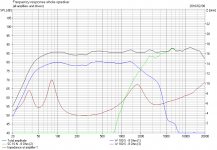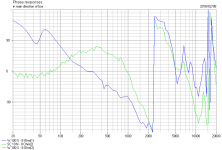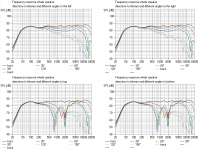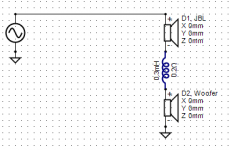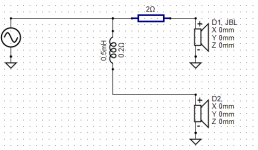That linked 2-way crossover calculator should be used as a ball-park guesser. It won't design an accurate crossover. This is what I think, anyhow. But it's a nice tool to use to learn a bit about crossovers. The link I posted a little way up got me much more accurate values.
100 Hz crossover is very low. My 6.5" woofers are crossed at 2.3 kHz. It's not easy to design for a speaker if you don't know it's frequency response, but it's safe to use a low resonance tweeter and a low crossover point (so, 600 - 700 Hz tweeter resonance and 1.2 kHz crossover point).
Ported vs sealed isn't just simply plugging up the port and listening to the difference - I think it's generally accepted that sealed boxes are well stuffed, while ported are minimally stuff, more lined with sound deadening. This is important because a stuffed sealed box will appear larger to the driver.
Anyway, I see you're really taking things seriously, which is awesome, and I do wish you the best of luck with this. It's incredibly rewarding. I'm now on my 4th iteration of my speaker build, and I've called it my final. It's as perfect as I could ever want.
100 Hz crossover is very low. My 6.5" woofers are crossed at 2.3 kHz. It's not easy to design for a speaker if you don't know it's frequency response, but it's safe to use a low resonance tweeter and a low crossover point (so, 600 - 700 Hz tweeter resonance and 1.2 kHz crossover point).
Ported vs sealed isn't just simply plugging up the port and listening to the difference - I think it's generally accepted that sealed boxes are well stuffed, while ported are minimally stuff, more lined with sound deadening. This is important because a stuffed sealed box will appear larger to the driver.
Anyway, I see you're really taking things seriously, which is awesome, and I do wish you the best of luck with this. It's incredibly rewarding. I'm now on my 4th iteration of my speaker build, and I've called it my final. It's as perfect as I could ever want.
Hi,A 170mm woofer would reasonably be expected to work up to 2Kc/s, so you could make your crossover that high which would generally work in with most tweeters with a low resonance of around 600 - 700 c/s. Use a LR2 crossover at 2Kc/s and pad down the tweeter to match the woofer.
Get some 'free' basic software tools to put yourself in the game of crossover design. The crossover will make or break your efforts in getting a satisfactory result.
Hope this might help somewhat, but beware, loudspeaker design can be habit forming.
C.M
This makes everything much more easy. I looked through some online stores I've been browsing and tweeters (specifically) with Fs 600 - 900 are not all that common. So from what I've red, it is somewhat accepted to make Full ranged + Sub setups. In this case, I'd have plenty of headroom on lower end. LR2 - with XO at 2 kHZ gives calming inductor values.
About full-range drivers - could I ask for opinion on - FR with cone vs FR without cone? I've seen some mixed reviews and without any gravity, just the extremes.
Regards
That linked 2-way crossover calculator should be used as a ball-park guesser. It won't design an accurate crossover. This is what I think, anyhow. But it's a nice tool to use to learn a bit about crossovers. The link I posted a little way up got me much more accurate values.
100 Hz crossover is very low. My 6.5" woofers are crossed at 2.3 kHz. It's not easy to design for a speaker if you don't know it's frequency response, but it's safe to use a low resonance tweeter and a low crossover point (so, 600 - 700 Hz tweeter resonance and 1.2 kHz crossover point).
Ported vs sealed isn't just simply plugging up the port and listening to the difference - I think it's generally accepted that sealed boxes are well stuffed, while ported are minimally stuff, more lined with sound deadening. This is important because a stuffed sealed box will appear larger to the driver.
Anyway, I see you're really taking things seriously, which is awesome, and I do wish you the best of luck with this. It's incredibly rewarding. I'm now on my 4th iteration of my speaker build, and I've called it my final. It's as perfect as I could ever want.
Hello,
I did not find links from you in previous comments. Could you please post what you have in mind? For my previous calculations I indeed used the one from diyaudioandvideo.com. Regarding the low XO frequency - it was purely based on previous setup for the subs I have. I am so glad this seems to not be the case and that they can actually handle much more.
I understand that vented requires larger volume than sealed and it's not just matter of putting the tube in, but with materials I had on hand + the small size factor I would like to achieve, I came to somewhat solution - by moving inner wall which separates the compartments, increase the volume, remove stuffing and adding a vent. But this seems to be failure by design, as
1. I won't be able to increase the volume that much
2. Full-range requires the it's own volume, which pretty much forbids moving of the inner wall
And as you wrote - currently worst case scenario is, I have to dump the plywood and some filter components.
Sorry, I must have posted the link somewhere else recently.
Introduction to designing crossovers without measurement
Having a look at the TS parameters, a 10 L sealed box should be the best option for the woofer. You'll get response down to about 40 Hz (-10 dB). Ported would need to have an incredibly long port (I didn't see this before).
Introduction to designing crossovers without measurement
Having a look at the TS parameters, a 10 L sealed box should be the best option for the woofer. You'll get response down to about 40 Hz (-10 dB). Ported would need to have an incredibly long port (I didn't see this before).
Sorry, I must have posted the link somewhere else recently.
Introduction to designing crossovers without measurement
I red the article and I'm missing two things (for the woofer), as far as I can tell.
1) Sensitivity - this could be addressed by just getting loud tweeter and then leveling it down until it fits?
2) Inductance of coil - thus I cannot calculate value for the cap for woofer impedance flattening. The increase of impedance at certain frequency means an audible increase in volume?
If so, then once again, - I have resistor value and I could adjust the capacitors size by test and trial. (But to be honest, I have no clue what value to even start guessing at)
I could order LCR meter but this would mean I would first have to wait about a month for that, and only then order all the rest. And I am inpatient.
Anyhow - I compared my calculations to the suggested components from DIY Audio & Video - everything is off about two times. So now I am confused, if I did not mess something up.
1) Yes, but even if you know the sensitivity of the woofer, the tweeter resistor still needs to be tuned to your preference. And resistors are fairly cheap anyway. A 2 ohm, 4.7 ohm, 6.8 ohm and 10 ohm are 4 values you can have and use in various combinations to tune the tweeter level.
2) Yes, and that's why you either leave out the impedance flattening, or use a simple 10 ohm, 18 uF.
To be honest, you're designing half blind. You're going to have to do the things you can't simulate or calculate by intuition or gut feel, or eventually by listening tests. I'm sure many people here can help you out on the intuition thing, based on experience with 6" - 7" woofers.
So, I was looking at those drivers. They look ok, but looking where they come from, one tends to be a little suspect of their quality. It sounds like you want to either build something or buy a good quality set of speakers. I'm definitely going to say that building is far more rewarding. Building your own amplifier is only for fun - you don't really save on cost. It's an expensive hobby. Speakers, on the other hand, are much cheaper to build than to buy, and you can really end up with something great.
Hand on my heart, my speakers I built (for R6000) sound as good as, perhaps better than in some areas, B&W CM10's I auditioned. They're not supposed to, by the sounds of things around here, and the general feeling I get from the community towards Visaton, but honestly, they're amazing.
You want to build bookshelf speakers. Those T17PL07C6 drivers you have might be decent in a sub woofer, and that would be easy to point you in the right direction. I'm going to guess they're 12 ohms each, so in parallel, you'll have a 6 ohm which, from the short bit of research I did, will take a 150 - 200 W amplifier without problems. Now, there are some seriously cool things you can do to get those to give you the really sub-bass, but let's focus on the bookshelf's (as an optional direction you may want to follow).
Look into the kits someone linked near the beginning. Otherwise, the Visaton Aria kit will sound great. If you want something a little cheaper than the Aria, a W130S-based bookshelf would be something to consider, and if you want something a bit more expensive, the Bijou or Bijou 170 would sound fantastic.
2) Yes, and that's why you either leave out the impedance flattening, or use a simple 10 ohm, 18 uF.
To be honest, you're designing half blind. You're going to have to do the things you can't simulate or calculate by intuition or gut feel, or eventually by listening tests. I'm sure many people here can help you out on the intuition thing, based on experience with 6" - 7" woofers.
So, I was looking at those drivers. They look ok, but looking where they come from, one tends to be a little suspect of their quality. It sounds like you want to either build something or buy a good quality set of speakers. I'm definitely going to say that building is far more rewarding. Building your own amplifier is only for fun - you don't really save on cost. It's an expensive hobby. Speakers, on the other hand, are much cheaper to build than to buy, and you can really end up with something great.
Hand on my heart, my speakers I built (for R6000) sound as good as, perhaps better than in some areas, B&W CM10's I auditioned. They're not supposed to, by the sounds of things around here, and the general feeling I get from the community towards Visaton, but honestly, they're amazing.
You want to build bookshelf speakers. Those T17PL07C6 drivers you have might be decent in a sub woofer, and that would be easy to point you in the right direction. I'm going to guess they're 12 ohms each, so in parallel, you'll have a 6 ohm which, from the short bit of research I did, will take a 150 - 200 W amplifier without problems. Now, there are some seriously cool things you can do to get those to give you the really sub-bass, but let's focus on the bookshelf's (as an optional direction you may want to follow).
Look into the kits someone linked near the beginning. Otherwise, the Visaton Aria kit will sound great. If you want something a little cheaper than the Aria, a W130S-based bookshelf would be something to consider, and if you want something a bit more expensive, the Bijou or Bijou 170 would sound fantastic.
Bookshelf MTM example
W100S-based MTM bookshelf design.
2x Visaton W 100 S 8 ohm
1x Visaton SC 10 N
Enclosure: 9.6 L, 1.6 cm MDF, 14.2 cm (W) x 38.2 cm (H) x 28.2 cm (D)
Driver placement:
W 100 S (1) @ 30.4 cm
SC 10 N @ 19.1 cm
W 100 S (2) @ 7.8 cm
Rear port @ 19.1 cm, 5 cm PVC pipe, 15.3 cm long (50 Hz)
60 W nominal (100 W max)
W100S-based MTM bookshelf design.
2x Visaton W 100 S 8 ohm
1x Visaton SC 10 N
Enclosure: 9.6 L, 1.6 cm MDF, 14.2 cm (W) x 38.2 cm (H) x 28.2 cm (D)
Driver placement:
W 100 S (1) @ 30.4 cm
SC 10 N @ 19.1 cm
W 100 S (2) @ 7.8 cm
Rear port @ 19.1 cm, 5 cm PVC pipe, 15.3 cm long (50 Hz)
60 W nominal (100 W max)
Attachments
Sorry, I must have posted the link somewhere else recently.
Introduction to designing crossovers without measurement
Having a look at the TS parameters, a 10 L sealed box should be the best option for the woofer. You'll get response down to about 40 Hz (-10 dB). Ported would need to have an incredibly long port (I didn't see this before).
You can also try my tutorial over at:
software
"Software and Measurement-less Design Tutorial"
Includes the freeware and an example set of files
Hi,
Few months have passed since I finished my first attempt at speaker building. Here's a little update (If anyone gets notified?). I do have to warn you up front - it could be cringy to some.
- While looking for some tweeters online, accidentally I got two JBL car speakers (gto 6537) with adjustable tweeter sensitivity -3db and decided to try my luck. With these, at least I was somewhat confident that the XO is done right for the JBLs.
Calculated coil value needed to cut off the original woofer (the one which I started this build with), destroyed an old transformer and wound the coil.
Next up, I slapped the two drivers in series and coil for the crossover, - configuration could be wrong according to some religions, but I like to experiment - I made the following sequence
1. JBL at possitive,
2. Coil,
3. Woofer off to ground
just to see what comes out. Put it all in a box and tested few familiar songs. First off, I immediately turned down the bass on amp, about -30%. Mids seem to be alright and highs get a bit distorted at higher volumes. Could the arrangement be to blame for some of the issues?
Or arrangement is the least of my issues?
Summary, - for the money I spent (Next to nothing) damn best speakers I've ever owned. In reality - much space for improvements.
I am not really planning to invest any money into these as I have next thing on my mind and resources will be put into that.
Thank you all, who helped and pointed me to right direction.
Regards
Few months have passed since I finished my first attempt at speaker building. Here's a little update (If anyone gets notified?). I do have to warn you up front - it could be cringy to some.
- While looking for some tweeters online, accidentally I got two JBL car speakers (gto 6537) with adjustable tweeter sensitivity -3db and decided to try my luck. With these, at least I was somewhat confident that the XO is done right for the JBLs.
Calculated coil value needed to cut off the original woofer (the one which I started this build with), destroyed an old transformer and wound the coil.
Next up, I slapped the two drivers in series and coil for the crossover, - configuration could be wrong according to some religions, but I like to experiment - I made the following sequence
1. JBL at possitive,
2. Coil,
3. Woofer off to ground
just to see what comes out. Put it all in a box and tested few familiar songs. First off, I immediately turned down the bass on amp, about -30%. Mids seem to be alright and highs get a bit distorted at higher volumes. Could the arrangement be to blame for some of the issues?
Or arrangement is the least of my issues?
Summary, - for the money I spent (Next to nothing) damn best speakers I've ever owned. In reality - much space for improvements.
I am not really planning to invest any money into these as I have next thing on my mind and resources will be put into that.
Thank you all, who helped and pointed me to right direction.
Regards
Definitely not a good arrangement of the drivers!! You are passing ALL of the power through the tweeter, it is no wonder it sounds distorted at higher volumes.
You should at the very least have a capacitor protecting the tweeter, note I've no experience with series crossovers, but what you have described sounds very wrong
Is the attached (ignore value of coil) like what you are describing? If so then it's no wonder you had to turn the bass down. The tweeter will only be reproducing low frequencies (that it shouldn't be) and attenuated in the range that it should be playing!
Tony.
You should at the very least have a capacitor protecting the tweeter, note I've no experience with series crossovers, but what you have described sounds very wrong
Is the attached (ignore value of coil) like what you are describing? If so then it's no wonder you had to turn the bass down. The tweeter will only be reproducing low frequencies (that it shouldn't be) and attenuated in the range that it should be playing!
Tony.
Attachments
Last edited:
The coil is in series, so it's limiting all drivers, and all drivers' impedance should be added for the LR circuit equivalent calculation. Rather put the coil in series with the woofer, and then put that whole circuit in parallel with the car speaker.
FWIW, car speakers generally have horrible crossovers and frequency responses. Still, JBL are better than most, and you could get some decent (albeit not high fidelity) sound out of this.
FWIW, car speakers generally have horrible crossovers and frequency responses. Still, JBL are better than most, and you could get some decent (albeit not high fidelity) sound out of this.
Hi,
That is correct, the arrangement is how I've wired it all up. I forgot to mention, that the JBLs, have their internal crossover, thus tweeter should not have full power going through. But by the looks of wire gauge, the coil seems a bit undershot.
I accept, that this could be wrong, indeed, but I did not figure this out on my own, if I recall correctly. Maybe you have some suggestions for re-wiring to put some logic in this?
To me the highs did not sound all that terrible, just at the last third to quarter of potentiometer did they started to seem off (but continues years of powertool using could be to blame ).
).
That is correct, the arrangement is how I've wired it all up. I forgot to mention, that the JBLs, have their internal crossover, thus tweeter should not have full power going through. But by the looks of wire gauge, the coil seems a bit undershot.
I accept, that this could be wrong, indeed, but I did not figure this out on my own, if I recall correctly. Maybe you have some suggestions for re-wiring to put some logic in this?
To me the highs did not sound all that terrible, just at the last third to quarter of potentiometer did they started to seem off (but continues years of powertool using could be to blame
First off, I immediately turned down the bass on amp, about -30%.
That's to be expected because your coil is a low-pass filter acting on all things in series with it, whether they're before or after the coil. And that's what I'm saying with my previous post.
Change it to this (picture, because the words were ineffective
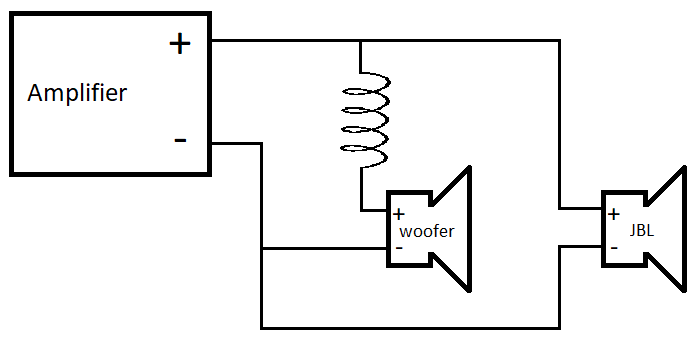
A 2 ohm resistor added in series with the tweeter would bring it up to 4 ohms and that should be safe. As it was "ok" with the coil in series, it probably needs some attenuation anyway 
like this.

Knowing the sensitivity of the woofer and the tweeter would help in determining the resistance required, but 2 ohms is probably the minimum you want from a perspective of protecting the amp, unless it is capable of driving very low impedances.
Tony.
like this.
Knowing the sensitivity of the woofer and the tweeter would help in determining the resistance required, but 2 ohms is probably the minimum you want from a perspective of protecting the amp, unless it is capable of driving very low impedances.
Tony.
Attachments
A 2 ohm resistor added in series with the [JBL]
Yes. I was going to add that in my original image, but I didn't, and then I didn't have time (work).
I would consider a 5.6 ohm resistor (20 W).
That's why I paired them in series, to not risk the amp, which handles 4 ohm load and above.
@Mrcloc - Sorry, did not see your first response before posting mine. But overall, I like pictures more, so thank you all for putting these together.
@wintermute - Unfortunately, sensitivity for the mystery sub is unknown to me. PeteMcK somewhere in this discussion pointed me to some other specs, but not the sensitivity. I can only assume, it could be listed in his source, which to me is not known.
Sensitivity for the JBL is 92 db, but this I assume is for the whole thing, not the tweeter only.
@Mrcloc - Sorry, did not see your first response before posting mine. But overall, I like pictures more, so thank you all for putting these together.
@wintermute - Unfortunately, sensitivity for the mystery sub is unknown to me. PeteMcK somewhere in this discussion pointed me to some other specs, but not the sensitivity. I can only assume, it could be listed in his source, which to me is not known.
Sensitivity for the JBL is 92 db, but this I assume is for the whole thing, not the tweeter only.
re:'this won't be needed' - I looked them up anyway:
Fs 60; Re 6.5; Qm 6.59; Qe .65; Sd 106; Vas 3.9
seems to model well in 10L tuned to 50Hz
If it is those params then the sensitivity is 83.7db so if the tweeter is 92 db you are going to need quite a bit of padding! Just a series resistor won't be enough you will need an LPAD I would think.
I'm off to bed, I'll leave that as a research assignment
Tony.
If it is those params then the sensitivity is 83.7db so if the tweeter is 92 db you are going to need quite a bit of padding! Tony.
Did some brief research on free time, and what I understand, padding with LPAD is not done for woofer, since for it there would be a lot of power dissipated, which would result with excessive heat. and eventual death for the lpad. And since tweeter is integrated into that JBL, padding only that is impossible. unless I alter with the internals.
I said 5.6 ohms series with the JBL because in the frequency range of the woofer, the JBL is going to add some. So the 5.6 ohm is likely going to dampen the > 100 Hz by almost 12 dB, and the JBL and the woofer will increase the lows by up to 3 dB for < 100 Hz (100 Hz is just an arbitrary point to illustrate my point).
So try that - wintermute's circuit with a 5.6 ohm (20 W) rather than a 2 ohm.
If you want to separate the JBL and the woofer completely, then you'll have to put a HPF on the JBL.
5.6 ohm + 2 ohm = 7.6 ohm. I think I remember that the woofer is 12 ohm, so ~8 ohm || 12 ohm is about 4.5 ohm, which your amp will be fine with.
So try that - wintermute's circuit with a 5.6 ohm (20 W) rather than a 2 ohm.
If you want to separate the JBL and the woofer completely, then you'll have to put a HPF on the JBL.
5.6 ohm + 2 ohm = 7.6 ohm. I think I remember that the woofer is 12 ohm, so ~8 ohm || 12 ohm is about 4.5 ohm, which your amp will be fine with.
- Status
- This old topic is closed. If you want to reopen this topic, contact a moderator using the "Report Post" button.
- Home
- Loudspeakers
- Multi-Way
- Mid and high range speakers

